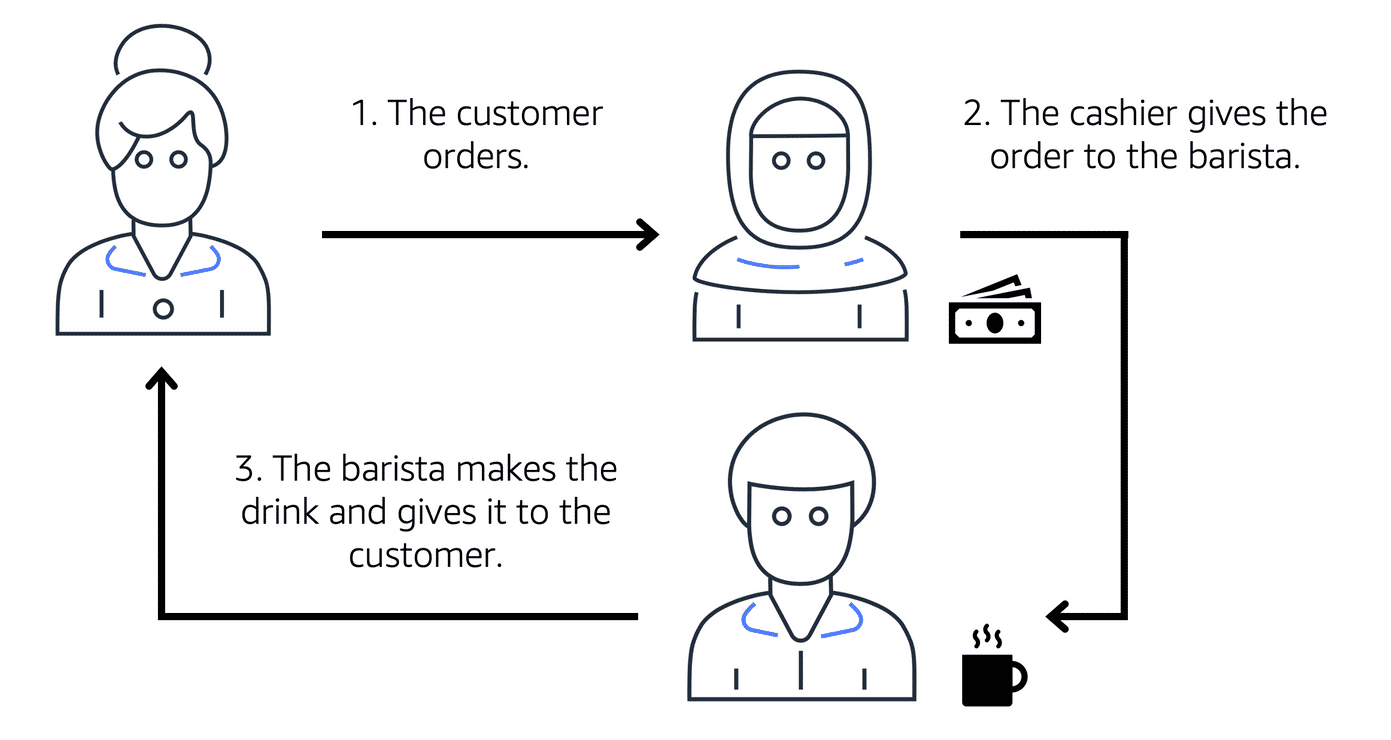
Please support if you like my work by payment through upi: sinhamit@icici or payment by bank
account name: Amit Kumar Sinha,
account number: 2646728782
IFSC code: KKBK0005660
SWIFT: KKBKINBB
aws 07 in Category: AWS_cloud by amit
🕙 Posted on 2023-12-08 at 12:47:00
Messaging and Queuing | संदेश भेजना और कतारबद्ध करना
Monolithic applications and microservices | अखंड अनुप्रयोग और माइक्रोसर्विसेज

Four rectangles close together in a larger square to indicate tightly coupled components as seen in monolithic applications.
चार आयतें कसकर युग्मित घटकों को इंगित करने के लिए एक बड़े वर्ग में एक साथ बंद हो जाती हैं जैसा कि मोनोलिथिक अनुप्रयोगों में देखा जाता है।
Applications are made of multiple components. The components communicate with each other to transmit data, fulfill requests, and keep the application running.
एप्लिकेशन कई घटकों से बने होते हैं। घटक डेटा संचारित करने, अनुरोधों को पूरा करने और एप्लिकेशन को चालू रखने के लिए एक दूसरे के साथ संवाद करते हैं।
Suppose that you have an application with tightly coupled components. These components might include databases, servers, the user interface, business logic, and so on. This type of architecture can be considered a monolithic application.
मान लीजिए कि आपके पास कसकर युग्मित घटकों वाला एक एप्लिकेशन है। इन घटकों में डेटाबेस, सर्वर, उपयोगकर्ता इंटरफ़ेस, व्यावसायिक तर्क इत्यादि शामिल हो सकते हैं। इस प्रकार की वास्तुकला को एक अखंड अनुप्रयोग माना जा सकता है।
In this approach to application architecture, if a single component fails, other components fail, and possibly the entire application fails.
एप्लिकेशन आर्किटेक्चर के इस दृष्टिकोण में, यदि एक घटक विफल हो जाता है, तो अन्य घटक विफल हो जाते हैं, और संभवतः संपूर्ण एप्लिकेशन विफल हो जाता है।
To help maintain application availability when a single component fails, you can design your application through a microservices approach.
किसी एकल घटक के विफल होने पर एप्लिकेशन की उपलब्धता बनाए रखने में मदद के लिए, आप अपने एप्लिकेशन को माइक्रोसर्विसेज दृष्टिकोण के माध्यम से डिज़ाइन कर सकते हैं।

Four rectangles with distance between them connected by lines in a rectangle pattern to indicate loosely coupled components.
शिथिल युग्मित घटकों को इंगित करने के लिए आयताकार पैटर्न में रेखाओं से जुड़े चार आयत जिनके बीच की दूरी है।
In a microservices approach, application components are loosely coupled. In this case, if a single component fails, the other components continue to work because they are communicating with each other. The loose coupling prevents the entire application from failing.
माइक्रोसर्विसेज दृष्टिकोण में, एप्लिकेशन घटक शिथिल रूप से युग्मित होते हैं। इस मामले में, यदि एक घटक विफल हो जाता है, तो अन्य घटक काम करना जारी रखते हैं क्योंकि वे एक दूसरे के साथ संचार कर रहे होते हैं। ढीला युग्मन पूरे एप्लिकेशन को विफल होने से रोकता है।
When designing applications on AWS, you can take a microservices approach with services and components that fulfill different functions. Two services facilitate application integration: Amazon Simple Notification Service (Amazon SNS) and Amazon Simple Queue Service (Amazon SQS).
AWS पर एप्लिकेशन डिज़ाइन करते समय, आप विभिन्न कार्यों को पूरा करने वाली सेवाओं और घटकों के साथ माइक्रोसर्विसेज दृष्टिकोण अपना सकते हैं। दो सेवाएँ एप्लिकेशन एकीकरण की सुविधा प्रदान करती हैं: अमेज़ॅन सिंपल नोटिफिकेशन सर्विस (अमेज़ॅन एसएनएस) और अमेज़ॅन सिंपल क्यू सर्विस (अमेज़ॅन एसक्यूएस)।
Amazon Simple Notification Service (Amazon SNS) | अमेज़ॅन सरल अधिसूचना सेवा (अमेज़ॅन एसएनएस)
Amazon Simple Notification Service (Amazon SNS) is a publish/subscribe service. Using Amazon SNS topics, a publisher publishes messages to subscribers. This is similar to the coffee shop; the cashier provides coffee orders to the barista who makes the drinks.
अमेज़ॅन सिंपल नोटिफिकेशन सर्विस (अमेज़ॅन एसएनएस) एक प्रकाशन/सदस्यता सेवा है। अमेज़ॅन एसएनएस विषयों का उपयोग करके, एक प्रकाशक ग्राहकों के लिए संदेश प्रकाशित करता है। यह कॉफ़ी शॉप के समान है; कैशियर पेय बनाने वाले बरिस्ता को कॉफी ऑर्डर प्रदान करता है।
In Amazon SNS, subscribers can be web servers, email addresses, AWS Lambda functions, or several other options.
अमेज़ॅन एसएनएस में, ग्राहक वेब सर्वर, ईमेल पते, एडब्ल्यूएस लैम्ब्डा फ़ंक्शन या कई अन्य विकल्प हो सकते हैं।
In the next lesson, you will learn more about AWS Lambda.
अगले पाठ में, आप AWS लैम्ब्डा के बारे में और जानेंगे।
To review two examples of how to use Amazon SNS, choose the arrow buttons to display each one.
अमेज़ॅन एसएनएस का उपयोग कैसे करें के दो उदाहरणों की समीक्षा करने के लिए, प्रत्येक को प्रदर्शित करने के लिए तीर बटन चुनें।
Step 1: Publishing updates from a single topic
चरण 1: किसी एक विषय से अपडेट प्रकाशित करना

Suppose that the coffee shop has a single newsletter that includes updates from all areas of its business. It includes topics such as coupons, coffee trivia, and new products. All of these topics are grouped because this is a single newsletter. All customers who subscribe to the newsletter receive updates about coupons, coffee trivia, and new products.
मान लीजिए कि कॉफ़ी शॉप के पास एक एकल न्यूज़लेटर है जिसमें उसके व्यवसाय के सभी क्षेत्रों के अपडेट शामिल हैं। इसमें कूपन, कॉफ़ी ट्रिविया और नए उत्पाद जैसे विषय शामिल हैं। इन सभी विषयों को समूहीकृत किया गया है क्योंकि यह एक एकल समाचार पत्र है। न्यूज़लेटर की सदस्यता लेने वाले सभी ग्राहकों को कूपन, कॉफ़ी ट्रिविया और नए उत्पादों के बारे में अपडेट प्राप्त होते हैं।
After a while, some customers express that they would prefer to receive separate newsletters for only the specific topics that interest them. The coffee shop owners decide to try this approach.
कुछ समय बाद, कुछ ग्राहक व्यक्त करते हैं कि वे केवल उन विशिष्ट विषयों के लिए अलग-अलग न्यूज़लेटर प्राप्त करना पसंद करेंगे जिनमें उनकी रुचि है। कॉफ़ी शॉप के मालिक इस दृष्टिकोण को आज़माने का निर्णय लेते हैं।
Step 2: Publishing updates from multiple topics
चरण 2: अनेक विषयों से अपडेट प्रकाशित करना

Now, instead of having a single newsletter for all topics, the coffee shop has broken it up into three separate newsletters. Each newsletter is devoted to a specific topic: coupons, coffee trivia, and new products.
अब, सभी विषयों के लिए एक ही न्यूज़लेटर रखने के बजाय, कॉफ़ी शॉप ने इसे तीन अलग-अलग न्यूज़लेटर्स में तोड़ दिया है। प्रत्येक न्यूज़लेटर एक विशिष्ट विषय के लिए समर्पित है: कूपन, कॉफ़ी ट्रिविया और नए उत्पाद।
Subscribers will now receive updates immediately for only the specific topics to which they have subscribed.
सब्सक्राइबर्स को अब केवल उन विशिष्ट विषयों के लिए तुरंत अपडेट प्राप्त होंगे जिनकी उन्होंने सदस्यता ली है।
It is possible for subscribers to subscribe to a single topic or to multiple topics. For example, the first customer subscribes to only the coupons topic, and the second subscriber subscribes to only the coffee trivia topic. The third customer subscribes to both the coffee trivia and new products topics.
ग्राहकों के लिए किसी एक विषय या एकाधिक विषयों की सदस्यता लेना संभव है। उदाहरण के लिए, पहला ग्राहक केवल कूपन विषय की सदस्यता लेता है, और दूसरा ग्राहक केवल कॉफ़ी ट्रिविया विषय की सदस्यता लेता है। तीसरा ग्राहक कॉफ़ी ट्रिविया और नए उत्पाद दोनों विषयों की सदस्यता लेता है।
Amazon Simple Queue Service (Amazon SQS) | अमेज़ॅन सरल कतार सेवा (अमेज़ॅन एसक्यूएस)
Amazon Simple Queue Service (Amazon SQS) is a message queuing service.
अमेज़ॅन सिंपल क्यू सर्विस (अमेज़ॅन एसक्यूएस) एक संदेश कतार सेवा है।
Using Amazon SQS, you can send, store, and receive messages between software components, without losing messages or requiring other services to be available. In Amazon SQS, an application sends messages into a queue. A user or service retrieves a message from the queue, processes it, and then deletes it from the queue.
अमेज़ॅन एसक्यूएस का उपयोग करके, आप संदेशों को खोए बिना या अन्य सेवाओं की उपलब्धता की आवश्यकता के बिना, सॉफ़्टवेयर घटकों के बीच संदेश भेज, संग्रहीत और प्राप्त कर सकते हैं। अमेज़ॅन एसक्यूएस में, एक एप्लिकेशन एक कतार में संदेश भेजता है। कोई उपयोगकर्ता या सेवा कतार से एक संदेश प्राप्त करता है, उसे संसाधित करता है, और फिर उसे कतार से हटा देता है।
To review two examples of how to use Amazon SQS, choose the arrow buttons to display each one.
अमेज़ॅन एसक्यूएस का उपयोग कैसे करें के दो उदाहरणों की समीक्षा करने के लिए, प्रत्येक को प्रदर्शित करने के लिए तीर बटन चुनें।
Example 1: Fulfilling an order | उदाहरण 1: एक आदेश पूरा करना

Suppose that the coffee shop has an ordering process in which a cashier takes orders, and a barista makes the orders. Think of the cashier and the barista as two separate components of an application.
मान लीजिए कि कॉफ़ी शॉप में ऑर्डर देने की एक प्रक्रिया है जिसमें एक कैशियर ऑर्डर लेता है, और एक बरिस्ता ऑर्डर करता है। कैशियर और बरिस्ता को एक एप्लिकेशन के दो अलग-अलग घटकों के रूप में सोचें।
First, the cashier takes an order and writes it down on a piece of paper. Next, the cashier delivers the paper to the barista. Finally, the barista makes the drink and gives it to the customer.
सबसे पहले, कैशियर एक ऑर्डर लेता है और उसे कागज के एक टुकड़े पर लिखता है। इसके बाद, कैशियर बरिस्ता को कागज़ सौंपता है। अंत में, बरिस्ता पेय बनाता है और ग्राहक को देता है।
When the next order comes in, the process repeats. This process runs smoothly as long as both the cashier and the barista are coordinated.
जब अगला ऑर्डर आता है, तो प्रक्रिया दोहराई जाती है। यह प्रक्रिया तब तक सुचारू रूप से चलती है जब तक कैशियर और बरिस्ता दोनों का समन्वय होता है।
What might happen if the cashier took an order and went to deliver it to the barista, but the barista was out on a break or busy with another order? The cashier would need to wait until the barista is ready to accept the order. This would cause delays in the ordering process and require customers to wait longer to receive their orders.
क्या हो सकता है यदि कैशियर एक ऑर्डर लेकर बरिस्ता को देने के लिए गया, लेकिन बरिस्ता छुट्टी पर था या किसी अन्य ऑर्डर में व्यस्त था? कैशियर को तब तक इंतजार करना होगा जब तक बरिस्ता ऑर्डर स्वीकार करने के लिए तैयार न हो जाए। इससे ऑर्डर प्रक्रिया में देरी होगी और ग्राहकों को अपना ऑर्डर प्राप्त करने के लिए अधिक समय तक इंतजार करना पड़ेगा।
As the coffee shop has become more popular and the ordering line is moving more slowly, the owners notice that the current ordering process is time consuming and inefficient. They decide to try a different approach that uses a queue.
जैसे-जैसे कॉफ़ी शॉप अधिक लोकप्रिय हो गई है और ऑर्डर देने की लाइन अधिक धीमी गति से आगे बढ़ रही है, मालिकों ने नोटिस किया है कि वर्तमान ऑर्डर प्रक्रिया समय लेने वाली और अक्षम है। वे एक अलग दृष्टिकोण आज़माने का निर्णय लेते हैं जो कतार का उपयोग करता है।
Example 2: Orders in a queue | उदाहरण 2: एक कतार में ऑर्डर

Recall that the cashier and the barista are two separate components of an application. A message queuing service, such as Amazon SQS, lets messages between decoupled application complements.
याद रखें कि कैशियर और बरिस्ता किसी एप्लिकेशन के दो अलग-अलग घटक हैं। एक संदेश कतार सेवा, जैसे कि अमेज़ॅन एसक्यूएस, डिकॉउल्ड एप्लिकेशन के बीच संदेशों को पूरक बनाती है।
In this example, the first step in the process remains the same as before: a customer places an order with the cashier.
इस उदाहरण में, प्रक्रिया का पहला चरण पहले जैसा ही रहता है: ग्राहक कैशियर के पास ऑर्डर देता है।
The cashier puts the order into a queue. You can think of this as an order board that serves as a buffer between the cashier and the barista. Even if the barista is out on a break or busy with another order, the cashier can continue placing new orders into the queue.
कैशियर ऑर्डर को कतार में रखता है। आप इसे एक ऑर्डर बोर्ड के रूप में सोच सकते हैं जो कैशियर और बरिस्ता के बीच एक बफर के रूप में कार्य करता है। भले ही बरिस्ता छुट्टी पर हो या किसी अन्य ऑर्डर में व्यस्त हो, कैशियर कतार में नए ऑर्डर देना जारी रख सकता है।
Next, the barista checks the queue and retrieves the order.
इसके बाद, बरिस्ता कतार की जाँच करता है और ऑर्डर पुनः प्राप्त करता है।
The barista prepares the drink and gives it to the customer.
बरिस्ता पेय तैयार करता है और ग्राहक को देता है।
The barista then removes the completed order from the queue.
इसके बाद बरिस्ता पूरे किए गए ऑर्डर को कतार से हटा देता है।
While the barista is preparing the drink, the cashier is able to continue taking new orders and add them to the queue.
जबकि बरिस्ता पेय तैयार कर रहा है, कैशियर नए ऑर्डर लेना जारी रख सकता है और उन्हें कतार में जोड़ सकता है।
- Amazon Simple Notification Service (Amazon SNS) is a publish/subscribe service. Using Amazon SNS topics, a publisher publishes messages to subscribers.
अमेज़ॅन सिंपल नोटिफिकेशन सर्विस (अमेज़ॅन एसएनएस) एक प्रकाशन/सदस्यता सेवा है। अमेज़ॅन एसएनएस विषयों का उपयोग करके, एक प्रकाशक ग्राहकों के लिए संदेश प्रकाशित करता है। - Amazon Simple Queue Service (Amazon SQS) is a message queuing service. It does not use the message subscription and topic model that is involved with Amazon SNS.
अमेज़ॅन सिंपल क्यू सर्विस (अमेज़ॅन एसक्यूएस) एक संदेश कतार सेवा है। यह संदेश सदस्यता और विषय मॉडल का उपयोग नहीं करता है जो अमेज़ॅन एसएनएस से जुड़ा हुआ है। - Amazon EC2 Auto Scaling enables you to automatically add or remove Amazon EC2 instances in response to changing application demand.
अमेज़ॅन EC2 ऑटो स्केलिंग आपको बदलती एप्लिकेशन मांग के जवाब में Amazon EC2 इंस्टेंस को स्वचालित रूप से जोड़ने या हटाने में सक्षम बनाता है। - Elastic Load Balancing is the AWS service that automatically distributes incoming application traffic across multiple resources, such as Amazon EC2 instances.
इलास्टिक लोड बैलेंसिंग AWS सेवा है जो आने वाले एप्लिकेशन ट्रैफ़िक को Amazon EC2 इंस्टेंसेस जैसे कई संसाधनों में स्वचालित रूप से वितरित करती है।
Let's talk about messaging and queuing. In the coffee shop, there are cashiers taking orders from the customers and baristas making the orders. Currently, the cashier takes the order, writes it down with a pen and paper, and delivers this order to the barista. The barista then takes the paper and makes the order. When the next order comes in, the process repeats. This works great as long as both the cashier and the barista are in sync. But what would happen if the cashier took the order and turned to pass it to the barista and the barista was out on break or busy with another order? Well, that cashier is stuck until the barista is ready to take the order. And at a certain point, the order will probably be dropped so the cashier can go serve the next customer.
चलिए मैसेजिंग और कतारबद्धता के बारे में बात करते हैं। कॉफ़ी शॉप में, कैशियर ग्राहकों से ऑर्डर ले रहे हैं और बरिस्ता ऑर्डर दे रहे हैं। वर्तमान में, कैशियर ऑर्डर लेता है, उसे पेन और कागज से लिखता है और इस ऑर्डर को बरिस्ता तक पहुंचाता है। फिर बरिस्ता कागज लेता है और ऑर्डर देता है। जब अगला ऑर्डर आता है, तो प्रक्रिया दोहराई जाती है। यह तब तक बढ़िया काम करता है जब तक कैशियर और बरिस्ता दोनों सिंक में हैं। लेकिन क्या होगा यदि कैशियर ऑर्डर लेकर बरिस्ता को देने के लिए मुड़े और बरिस्ता छुट्टी पर हो या किसी अन्य ऑर्डर में व्यस्त हो? खैर, वह कैशियर तब तक रुका रहता है जब तक बरिस्ता ऑर्डर लेने के लिए तैयार नहीं हो जाता। और एक निश्चित बिंदु पर, ऑर्डर संभवतः छोड़ दिया जाएगा ताकि कैशियर अगले ग्राहक को सेवा दे सके।
You can see how this is a flawed process, because as soon as either the cashier or barista is out of sync, the process will degrade, causing slow downs in receiving orders and failures to complete orders at all. A much better process would be to introduce some sort of buffer or queue into the system. Instead of handing the order directly to the barista, the cashier would post the order to some sort of buffer, like an order board.
आप देख सकते हैं कि यह कैसे एक त्रुटिपूर्ण प्रक्रिया है, क्योंकि जैसे ही कैशियर या बरिस्ता सिंक से बाहर हो जाएगा, प्रक्रिया ख़राब हो जाएगी, जिससे ऑर्डर प्राप्त करने में धीमी गति आएगी और ऑर्डर पूरा करने में विफलता होगी। सिस्टम में किसी प्रकार का बफ़र या कतार शामिल करना एक बेहतर प्रक्रिया होगी। ऑर्डर को सीधे बरिस्ता को सौंपने के बजाय, कैशियर ऑर्डर को ऑर्डर बोर्ड की तरह किसी प्रकार के बफर पर पोस्ट कर देगा।
This idea of placing messages into a buffer is called messaging and queuing. Just as our cashier sends orders to the barista, applications send messages to each other to communicate. If applications communicate directly like our cashier and barista previously, this is called being tightly coupled.
संदेशों को बफ़र में रखने के इस विचार को मैसेजिंग और कतारबद्ध करना कहा जाता है। जिस तरह हमारा कैशियर बरिस्ता को ऑर्डर भेजता है, उसी तरह एप्लिकेशन संवाद करने के लिए एक-दूसरे को संदेश भेजते हैं। यदि एप्लिकेशन पहले हमारे कैशियर और बरिस्ता की तरह सीधे संवाद करते हैं, तो इसे कसकर युग्मित होना कहा जाता है।
A hallmark trait of a tightly coupled architecture is where if a single component fails or changes, it causes issues for other components or even the whole system. For example, if we have Application A and it is sending messages directly to Application B, if Application B has a failure and cannot accept those messages, Application A will begin to see errors as well. This is a tightly coupled architecture.
कसकर युग्मित वास्तुकला की एक विशिष्ट विशेषता यह है कि यदि एक घटक विफल हो जाता है या बदल जाता है, तो यह अन्य घटकों या यहां तक कि पूरे सिस्टम के लिए समस्याएं पैदा करता है। उदाहरण के लिए, यदि हमारे पास एप्लिकेशन ए है और यह सीधे एप्लिकेशन बी को संदेश भेज रहा है, यदि एप्लिकेशन बी में विफलता है और उन संदेशों को स्वीकार नहीं कर सकता है, तो एप्लिकेशन ए में भी त्रुटियां दिखाई देने लगेंगी। यह कसकर युग्मित वास्तुकला है।
A more reliable architecture is loosely coupled. This is an architecture where if one component fails, it is isolated and therefore won't cause cascading failures throughout the whole system. If we coded the application to use a more loosely coupled architecture, it could look as follows.
एक अधिक विश्वसनीय आर्किटेक्चर शिथिल रूप से युग्मित है। यह एक आर्किटेक्चर है जहां यदि एक घटक विफल हो जाता है, तो इसे अलग कर दिया जाता है और इसलिए पूरे सिस्टम में व्यापक विफलता नहीं होगी। यदि हम एप्लिकेशन को अधिक शिथिल युग्मित आर्किटेक्चर का उपयोग करने के लिए कोडित करते हैं, तो यह इस प्रकार दिख सकता है।
Just like our cashier and barista, we introduced a buffer between the two. In this case, we introduced a message queue. Messages are sent into the queue by Application A and they are processed by Application B. If Application B fails, Application A doesn't experience any disruption. Messages being sent can still be sent to the queue and will remain there until they are eventually processed.
हमारे कैशियर और बरिस्ता की तरह, हमने दोनों के बीच एक बफर पेश किया। इस मामले में, हमने एक संदेश कतार पेश की। संदेशों को एप्लिकेशन ए द्वारा कतार में भेजा जाता है और उन्हें एप्लिकेशन बी द्वारा संसाधित किया जाता है। यदि एप्लिकेशन बी विफल हो जाता है, तो एप्लिकेशन ए को किसी भी व्यवधान का अनुभव नहीं होता है। भेजे जा रहे संदेश अभी भी कतार में भेजे जा सकते हैं और अंततः संसाधित होने तक वहीं रहेंगे।
This is loosely coupled. This is what we strive to achieve with architectures on AWS. And this brings me to two AWS services that can assist in this regard. Amazon Simple Queue Service or SQS and Amazon Simple Notification Service or SNS. But before I dive into those two services, let me just order a to-go coffee on our cafe website. Done. All right, well, that's great. I should get a message when that order is ready.
यह शिथिल रूप से युग्मित है. AWS पर आर्किटेक्चर के साथ हम यही हासिल करने का प्रयास करते हैं। और यह मुझे दो AWS सेवाओं तक लाता है जो इस संबंध में सहायता कर सकती हैं। अमेज़ॅन सिंपल क्यू सर्विस या एसक्यूएस और अमेज़ॅन सिंपल नोटिफिकेशन सर्विस या एसएनएस। लेकिन इससे पहले कि मैं उन दो सेवाओं के बारे में बात करूं, मैं हमारी कैफे वेबसाइट पर एक कॉफी का ऑर्डर करना चाहूंगा। हो गया। ठीक है, ठीक है, यह बहुत अच्छा है। जब वह ऑर्डर तैयार हो जाए तो मुझे एक संदेश मिलना चाहिए।
First up, let's discuss Amazon SQS. SQS allows you to send, store, and receive messages between software components at any volume. This is without losing messages or requiring other services to be available. Think of messages as our coffee orders and the order board as an SQS queue. Messages have the person's name, coffee order, and time they ordered. The data contained within a message is called a payload, and it's protected until delivery. SQS queues are where messages are placed until they are processed. And AWS manages the underlying infrastructure for you to host those queues. These scale automatically, are reliable, and are easy to configure and use.
सबसे पहले, आइए Amazon SQS पर चर्चा करें। SQS आपको किसी भी वॉल्यूम पर सॉफ़्टवेयर घटकों के बीच संदेश भेजने, संग्रहीत करने और प्राप्त करने की अनुमति देता है। यह संदेशों को खोए बिना या अन्य सेवाओं के उपलब्ध होने की आवश्यकता के बिना है। संदेशों को हमारे कॉफ़ी ऑर्डर और ऑर्डर बोर्ड को SQS कतार के रूप में सोचें। संदेशों में व्यक्ति का नाम, कॉफ़ी ऑर्डर और उनके द्वारा ऑर्डर किए गए समय का विवरण होता है। किसी संदेश में मौजूद डेटा को पेलोड कहा जाता है, और यह डिलीवरी तक सुरक्षित रहता है। एसक्यूएस कतारें वह हैं जहां संदेशों को संसाधित होने तक रखा जाता है। और AWS आपके लिए उन कतारों को होस्ट करने के लिए अंतर्निहित बुनियादी ढांचे का प्रबंधन करता है। ये पैमाने स्वचालित रूप से विश्वसनीय हैं, और कॉन्फ़िगर करने और उपयोग करने में आसान हैं।
Now, Amazon SNS is similar in that it is used to send out messages to services, but it can also send out notifications to end users. It does this in a different way called a publish/subscribe or pub/sub model. This means that you can create something called an SNS topic which is just a channel for messages to be delivered. You then configure subscribers to that topic and finally publish messages for those subscribers. In practice, that means you can send one message to a topic which will then fan out to all the subscribers in a single go. These subscribers can also be endpoints such as SQS queues, AWS Lambda functions, and HTTPS or HTTP web hooks.
अब, अमेज़ॅन एसएनएस भी इसी तरह है कि इसका उपयोग सेवाओं को संदेश भेजने के लिए किया जाता है, लेकिन यह अंतिम उपयोगकर्ताओं को सूचनाएं भी भेज सकता है। यह इसे एक अलग तरीके से करता है जिसे पब्लिश/सब्सक्राइब या पब/सब मॉडल कहा जाता है। इसका मतलब यह है कि आप एसएनएस विषय नाम से कुछ बना सकते हैं जो संदेशों को वितरित करने के लिए सिर्फ एक चैनल है। फिर आप ग्राहकों को उस विषय पर कॉन्फ़िगर करते हैं और अंततः उन ग्राहकों के लिए संदेश प्रकाशित करते हैं। व्यवहार में, इसका मतलब है कि आप किसी विषय पर एक संदेश भेज सकते हैं जो एक ही बार में सभी ग्राहकों तक पहुंच जाएगा। ये सब्सक्राइबर SQS कतार, AWS लैम्ब्डा फ़ंक्शन और HTTPS या HTTP वेब हुक जैसे एंडपॉइंट भी हो सकते हैं।
Additionally, SNS can be used to fan out notifications to end users using mobile push, SMS, and email. Taking this back to our coffee shop, we could send out a notification when a customer's order is ready. This could be a simple SMS to let them know to pick it up or even a mobile push.
इसके अतिरिक्त, एसएनएस का उपयोग मोबाइल पुश, एसएमएस और ईमेल का उपयोग करके अंतिम उपयोगकर्ताओं तक सूचनाएं पहुंचाने के लिए किया जा सकता है। इसे वापस अपनी कॉफ़ी शॉप में ले जाकर, ग्राहक का ऑर्डर तैयार होने पर हम एक अधिसूचना भेज सकते हैं। यह उन्हें इसे लेने के लिए सूचित करने के लिए एक साधारण एसएमएस या यहां तक कि एक मोबाइल पुश भी हो सकता है।
In fact, it looks like my phone just received a message. Looks like my order is ready. See you soon...
वास्तव में, ऐसा लगता है कि मेरे फ़ोन पर अभी-अभी एक संदेश प्राप्त हुआ है। लगता है मेरा ऑर्डर तैयार है. जल्द ही फिर मिलेंगे...
Leave a Comment:

Amit Sinha March 2nd, 2023 at 9:30 PM
😃 😄 😁 😆 😅 😂 😉 😊 😇 😍 😘 😚 😋 😜 😝 😶 😏 😒 😌 😔 😪 😷 😵 😎 😲 😳 😨 😰 😥 😢 😭 😱 😖 😣 😞 😓 😩 😫 😤

Ribhu March 3rd, 2023 at 9:30 PM
🐵 🐒 🐶 🐩 🐺 🐱 🐯 🐅 🐆 🐴 🐎 🐮 🐂 🐃 🐄 🐷 🐖 🐗 🐽 🐏 🐑 🐐 🐪 🐫 🐘 🐭 🐁 🐀 🐹 🐰 🐇

